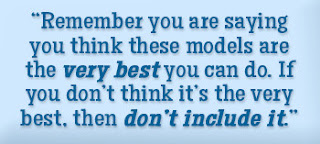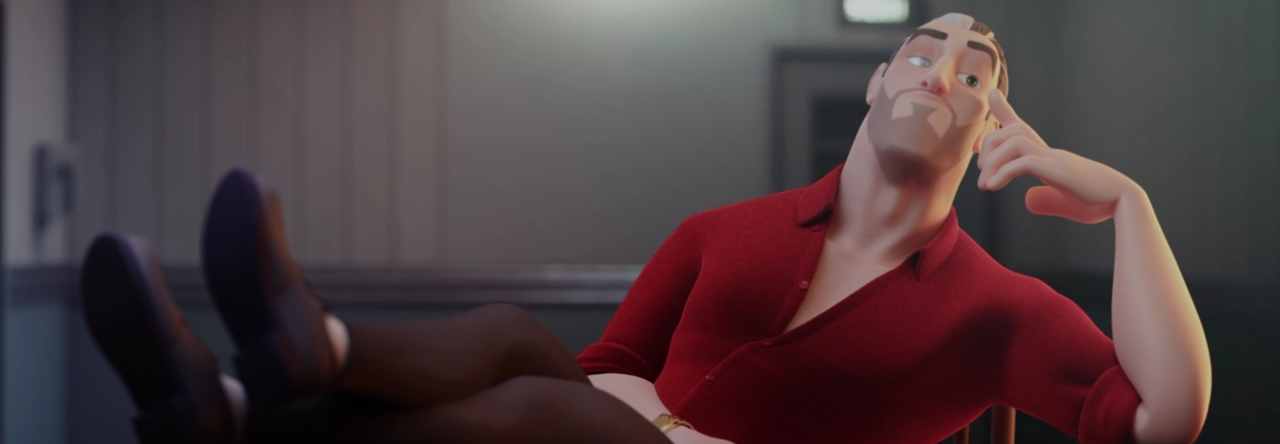Carlos Rivas was one of our most helpful students. He would always give his support to his classmates and would never hesitate to share his resources. It was a delight to interview him.
Carlos tell us about yourself and your background.
I am a Peruvian and I live in Lima City. Ever since I was a child, I have been in love with cartoons and especially “The Simpsons” series. I am a huge fan. I also remember how I loved watching the making of the show, “Woody Woodpecker” after each episode. I was always amazed to see those drawings come to life and take on personalities to become characters that would make me laugh. I spent a lot of my childhood time drawing cartoons on the corner of my books during lectures. Later I started using flipbooks to draw characters and had fun going back and forth drawing and feeling like a director.
I also like music and acting. I love watching movies in cinemas and studying them for better acting choices and compositions. I love to travel in my free time as well but that doesn’t happen as often as I’d like.
So what motivated you to join the 3D animation field?
When I finished school I wasn’t sure what I was going to study, I knew it had to be something related to drawing or design. While I was deciding my field, Shrek got released and instantly became the talk of the town. Everyone was talking about it and when I got a chance to watch it in the cinema, I instantly fell in love. I had to know how it was all made. They were not just drawings so I started my investigation and that was the first time I learnt about 3D animation process. In Peru, we had no proper teaching program regarding this field so I started searching for local 3D studios to join and learn everything related to it. I signed up with one that provided me a basic level of understanding for all areas of 3D field like modeling, rigging, animation, texturing, lighting so I learned a little bit of everything and I realized that animation was the one I enjoyed the most so when when studio needed interns for only animation, I signed up. This gave me a chance to learn from the local talented animators and I had a great time there. It was a dream come true when I worked on my first animation movie there.
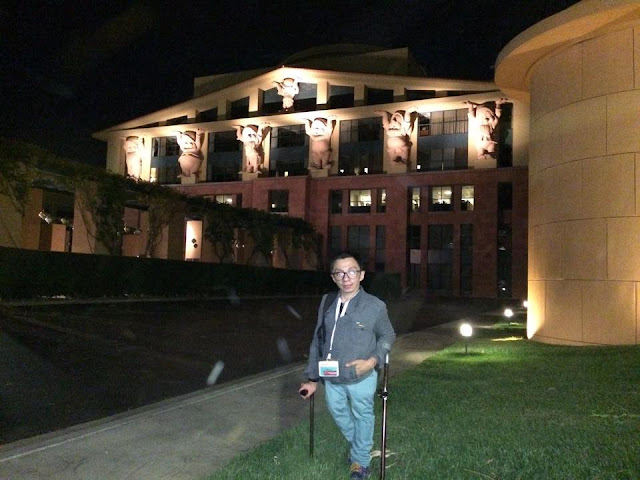 |
| Carlos Rivas at Disney Studio tour |
What made you decide to join AnimSchool’s animation program?
After we finished the movie, I realized that even though I knew more about animation than ever before, there was more to this field. It’s like a rabbit hole. There is always room for more knowledge and improvement. So I knew I had to reach next level. I started considering my options and checking the local community when I met a friend who was learning from an online school. It was like a perfect solution. I could learn from animators working in top studios from my home. I was excited. I chose AnimSchool because I liked their students showcase. AnimSchool also offered qualified teachers, live clases and general reviews. I couldn’t ask for more and joined it.
How did the instructors help you hone your animation skill?
First of all, I was amazed by the level of dedication and patience my instructors showed in all of my classes. It was refreshing to meet teachers that were this much invested in what students were doing and were genuinely trying to help and make them animate better. For me, term 4 was a break through. I knew many things before, principles and all but they clicked during this term. My instructor Trevor Young and atrium runner Nigel Style helped me see lots of tiny, tiny things that I had no idea about. Their critiques and feedback pushed me further. There were a lot of resources at my disposal and I was.. I was super excited. I couldn’t ask for more. It was awesome.
Tell us about your workflow?
It depends on my shots but since I mostly handle dialogue shots, I’d discuss it here. First I listen to the audio again and again to get the feel of it. If there is a storyboard, I’d take a look at it too. These two help me get an idea of character and how he should act. After this I shoot reference. This is where I play with different acting choices and let the creative ideas flow. I then take a look at what I shot. I cut and join different footage together to get what I want. Now is the time when I sit and, based on my acting choices, draw thumbnails. I draw only story telling poses and push them to get strong and clear line of action. Once I am happy with my thumbnails, I move to Maya and play with rigs and cameras. After I am happy with my set up, I start posing my character in 3D based on my drawings and see if they are working. When I am happy, I add more poses and keep on adding till I reach 4’s (one pose for every four frames). This is the time where I hit spline.
Now the first thing I do is to hide arms. I work only with body for couple of hours to make sure mechanics are working and performance is clear then I put them back again and start polishing it all together. I polish facial expressions and lip sync in the end and get the performance that I want.
I always make sure to show my work in progress to others at each stage. It is really important for me to get feedback of other animators. Their fresh eyes help you see things that you might not be seeing because your eyes have gotten used to seeing the scene.
You met us when you came to receive your graduation certificate. How was your experience, going to America and attending CTN?
CTN 2014 was everything I expected and then some more. It exceeded my expectations and I tell you, I had HUGE expectations to begin with. It was an adventure I will never forget. I got the chance to meet AnimSchool crew and instructors first time in flesh and blood. It was amazing. I met all my online fellow students which was really cool.
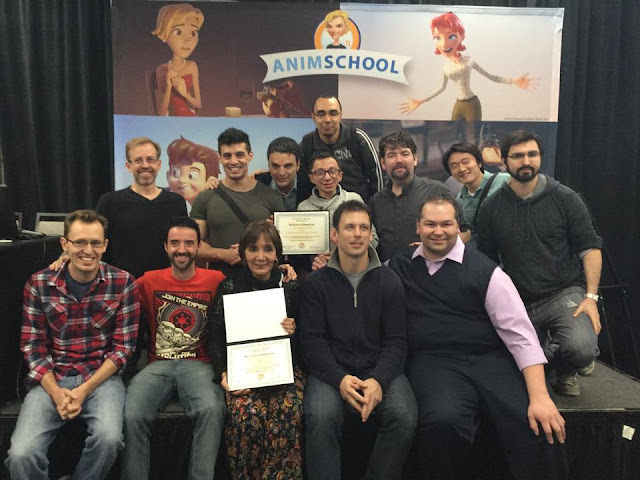 |
| Graduation ceremony with David Gallagher, AnimSchool staff, and students at CTN booth. |
I met many talented directors, animators, modelers, sculptors but nothing beats the time I met Glen Keane. I was awestruck.
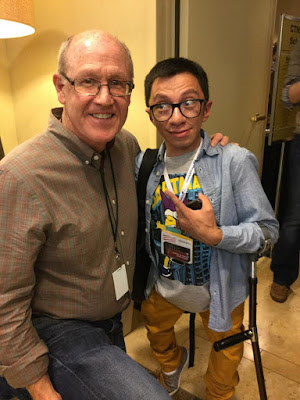 |
| Carlos Rivas with Glenn Keane |
It was interesting how it all happened. I was very disappointed that I couldn’t buy ticket to his workshop because they got sold out so quickly. So I got ticket to another workshop and as I was walking down the hall, a guy who looked like Glenn passed me. I didn’t realize it was him till after like 40 frames.
I turned and tried to catch up with him all the while thinking: “please be Glenn, please be Glenn”. When I got closer, it was Glenn and at that time I just stopped thinking. I was that pumped. I put myself right in front of him and popped my hand out and with a huge grin on my face, I said, “Hi!!”. I just had to. Haha. He stopped and he was very nice. He shook my hand and said, “Hi”. Then he started to chat and we talked for about 5 mins. He gave me an autograph and I took a picture with him. It was so so cool. I still can’t believe I met him. So glad I have this photo.
AnimSchool instructor Tony Bonilla arranged a Disney Studio tour for all the AnimSchool students. It was incredible and the whole time I was super happy. I couldn’t believe I was at THE Disney Studios. I met animators and AnimSchool instructors that were working there. They arranged screening of Frozen’s short film for us. I also saw sneak peak of Zootopia that was in production that time.
Being at Disney Studios, among Disney animators was everything I ever hoped for. It was amazing.
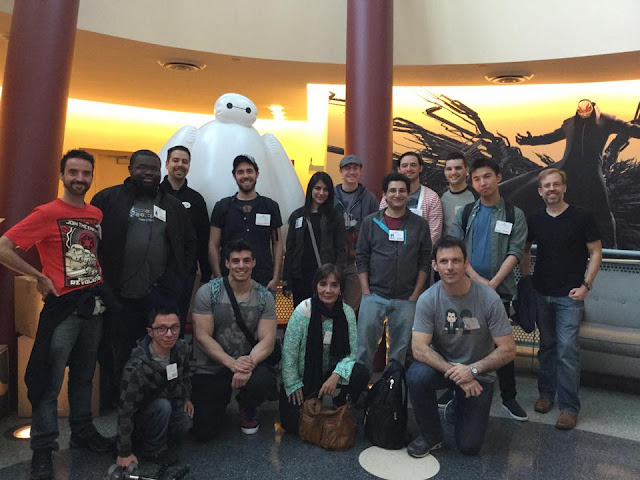 |
| AnimSchool students and teachers at Disney Studios |
What are you up to now?
Peru animation industry is slowly gaining momentum. After finishing AnimSchool, my friends and I founded our very own studio called “Golem Studio”. In our initial years, we worked on Tv Spot and Tv Series and currently, we are working on our first film called “Dalia and the Red Book”. It is a co-production with “Vista Sur” of Argentina. It is in its initial phases. With this project in our hand, we want to demonstrate that not only Peru can develop great stories but has CGI industry advanced enough to handle the technical aspects of it as well. We want to expand what CGI industry we have in Peru to all the Latin American countries.
Of course, we want our Golem Studio to evolve, expand and become the best studio of Latin America in the production of 3D movies. We look forward to colleaborations with other big studios and we are glad that we are on the right path.
I am also teaching animation at a local institute in Peru. The vision I share with other Peruvian animators and digital artists needs to have a steady stream of young artists to grow and expand. I am very thankful to AnimSchool for teaching me and helping me reach this point in life where I am giving back to my small community. We have a long way to go but I am part of this amazing journey and I couldn’t be happier.
Is there any advice you want to give to the aspiring animators?
Don’t be shy. Ask for feedback all the time. There is no shame in asking and the way animation is, you have to constantly get feeback and critiques to improve on it. This is important if you want to take your shot to next level as well.
Happy animating. J

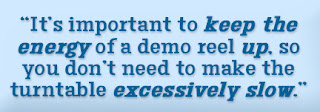 Be sensitive to screen time. Remember that professionals are looking at your work, and they can tell within a few seconds if it’s good or not. It’s important to keep the energy of a demo reel up, so you don’t need to make the turntable excessively slow. Generally about 3 rotations within 5 seconds is enough, which includes almost a full rotation with the wireframe comped onto the model. Start the turntable almost a full second before the most important side of the model, which typically includes the face. This gives you time to cross dissolve from your previous model, as well as giving the viewer enough time to figure out what she or he is looking at. It’s a bit annoying to have to wait a full second to see the face, but I’ve seen many turntables that start out on the face, but includes a cross dissolve, so we are essentially seeing the backside of the model first. It’s a good way to kill the moment of the demo reel. Further, end the rotation in a smart place. It doesn’t have to be where you began it, but you want to leave the model in an interesting place. It makes a better impression. Generally, 2 seconds or so per rotation is good, but it really depends on the model. I would say 4 seconds is pushing it in terms of speed.
Be sensitive to screen time. Remember that professionals are looking at your work, and they can tell within a few seconds if it’s good or not. It’s important to keep the energy of a demo reel up, so you don’t need to make the turntable excessively slow. Generally about 3 rotations within 5 seconds is enough, which includes almost a full rotation with the wireframe comped onto the model. Start the turntable almost a full second before the most important side of the model, which typically includes the face. This gives you time to cross dissolve from your previous model, as well as giving the viewer enough time to figure out what she or he is looking at. It’s a bit annoying to have to wait a full second to see the face, but I’ve seen many turntables that start out on the face, but includes a cross dissolve, so we are essentially seeing the backside of the model first. It’s a good way to kill the moment of the demo reel. Further, end the rotation in a smart place. It doesn’t have to be where you began it, but you want to leave the model in an interesting place. It makes a better impression. Generally, 2 seconds or so per rotation is good, but it really depends on the model. I would say 4 seconds is pushing it in terms of speed.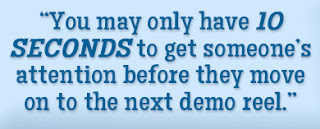 Many people have different opinions on this matter. I think best first, second second and third last is best. You may only have 10 seconds to get someone’s attention before they move on to the next demo reel, so it’d be a shame if they never saw what you consider to be your second best work if it is last. That said, you want to end strong and leave a good impression. The third best model is generally enough to do that.
Many people have different opinions on this matter. I think best first, second second and third last is best. You may only have 10 seconds to get someone’s attention before they move on to the next demo reel, so it’d be a shame if they never saw what you consider to be your second best work if it is last. That said, you want to end strong and leave a good impression. The third best model is generally enough to do that.